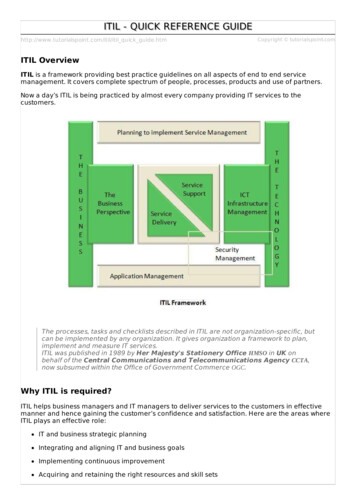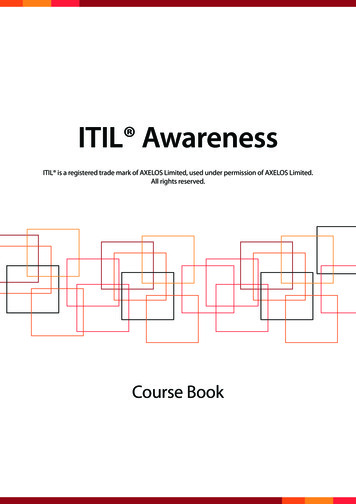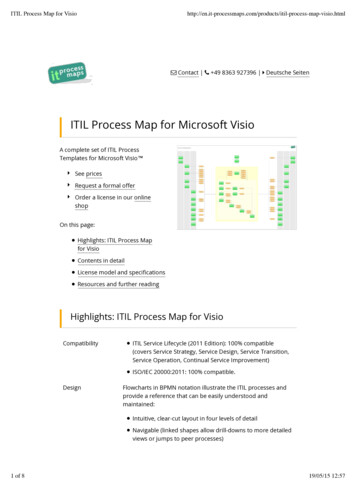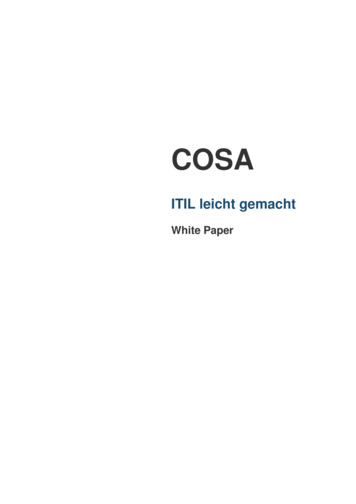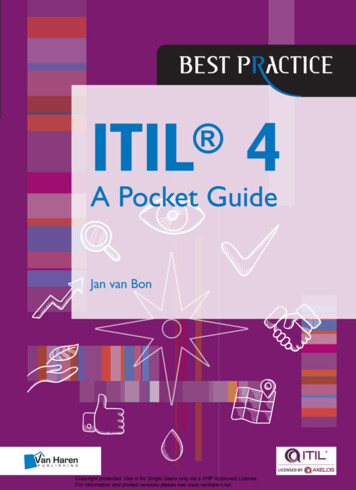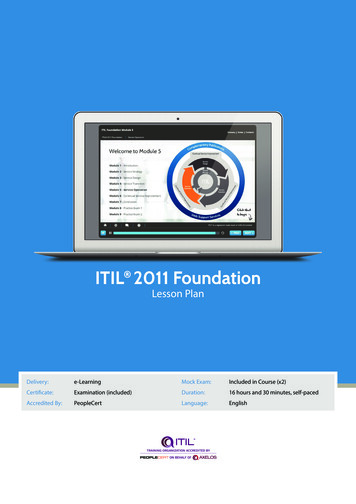
Transcription
WHITE PAPERITIL That Fits Your BusinessBy Bridget Conrad, VP Services and Support
ITIL THAT FITS YOUR BUSINESSTable of Contents3Introduction3What is ITIL?345Implementing ITIL56667782Adoption of ITILA moving target – The evolving ’best practices’ of ITILWhere to beginBasic questions to askStart with the most urgent processesSoftware tools – flexibility is the keyAgiloft has the flexibility you needImplementation consultants can save you time and moneyConclusionWHITE PAPER
ITIL THAT FITS YOUR BUSINESSIntroductionIn the last several years, ITIL has become a buzzwordin management circles. CEO’s and CIO’s anxiousto stay at the forefront of business trends have feltsome pressure to adopt “the most widely acceptedapproach to IT service management in the world.”1ITIL has been portrayed by some as a panacea thatwill suddenly make IT a profit center, while improvingservices, reliability, infrastructure, and accountability.WHITE PAPERITIL books investigated the actual practices ofcorporations as well as government agencies in theUK and abroad, looking for the process elementsthat led to effective IT service delivery, and they thencodified those elements. The ITIL books thereforedocumented practices already being followed tosome extent in many successful organizations.However, jumping into “implementing ITIL” withouta clear understanding of how best to go about itand what potential benefits and pitfalls you mayencounter is tantamount to jumping out of a planewith your company’s resources on your back insteadof a parachute.A significant percentage of ITIL implementations aresimply never completed, after months of training,certification tests, and effort, while it is also commonto find that an ITIL implementation has actuallyincreased the workload of IT staff members withoutimproving service or reliability.Both of these outcomes may be avoided by doingsome homework and approaching ITIL with a clearsense of priorities. This paper offers some practicalsuggestions for how to get the greatest benefits ITILhas to offer without getting lost along the way.What is ITIL?The Information Technology InfrastructureLibrary (ITIL) is a set of “best practice” guidelineson managing IT processes that were originallydeveloped for government agencies in the UnitedKingdom in 1989. The guidelines were created byan organization called the Central Computer andTelecommunications Agency (CCTA) in response towhat was perceived as the inefficiencies and failingsof IT in the British government.The purpose of the guidelines was to increaseefficiency and cost-effectiveness, reduce failure,and improve the customer service provided byIT organizations. The agency that created the1. entre/Best-Practice-Guidance/ITIL/3Adoption of ITILITIL quickly became a well-known standard in Europeand much of the world soon after its introduction,thanks in part to the IT Service Management Forum(itSMF), an international organization founded inthe early 1990s to spread the word about ITIL. TheUK and the Netherlands each created their own ITILuser certification programs in 2000 and hundreds ofthousands of individuals have been certified.ITIL has been slower to gain ground in the UnitedStates. Only in the last 5 years has it made realinroads among American corporations. The lag inAmerican adoption has been blamed by some oncultural differences. Ken Hamilton, past presidentof itSMF in the USA, explains, “Europe tends to bea qualitative environment. Process improvement interms of the quality of service delivered, these sortsof metrics were more popular in Europe-whereas inthe United States, cost savings, return on investment,hard-dollar savings were the primary drivers.”2The interest in ITIL adoption in the U.S. has beengrowing, however, as indicated by changing survey2. Chad Vander Veen, “American ITIL”, Jul 27, 2005 Government Technology, (http://www.govtech.com/gt/articles/95672?id 95672&full 1&story pg 2).
ITIL THAT FITS YOUR BUSINESSresults. In October 2005, a U.S. survey on theComputer Economics website showed that 56%of respondents weren’t even familiar with ITIL andanother 11% had no plans to implement it:3Current State of ITIL AdoptionNo Plans11%Researching16%ImplementingIn Place12%6%“What is ITIL”56%0%20%40%60%Percent of RespondentsSource: Computer EconomicsFigure 1By February of 2008, a survey of 370 CIO’sworldwide (100 of them American) by DimensionData found that almost 59% of American CIO’ssaid they had “engaged with” ITIL, but only 8%of them “deemed themselves aligned to the ITILframework).4 Contrast that with 66% of organizationsoutside the U.S. engaging with and 17% consideringthemselves to be true practitioners of ITIL.The main barriers to adoption cited by the surveywere the costs associated with training, certification,and implementation. 31% of U.S. CIO’s reported thatthe framework should be more actionable, while 25%complained that it should be more flexible. 40% ofAmerican CIO’s believed that ITIL would facilitateinnovation by freeing IT departments from routinetasks.Most U.S. companies implementing ITIL havebeen large corporations. This is not surprising,since ITIL was originally developed to addressthe problems of large organizations, and many ofthese problems may not even exist for small tomidsized organizations. For instance, a processaimed at improving communication between largedepartments will make little sense in a business withfewer than twenty employees. Moving to a tightly3. “ITIL Adoption: 2006 Could be Watershed Year in U.S.”,October, 2005, Computer Economics Metrics for IT Management, http://www.computereconomics.com/article.cfm?id 10684. “Dimension Data Survey Shows More than Half of U.S.Organizations Have Engaged with ITIL”, Feb. 28, 2008, veyShowsMore ThanHalfofUSOrganizati.pdf)4WHITE PAPERstructured, standards-based approach is mostlikely to pay off for companies juggling a variety ofindependent systems in separate departments thatdon’t talk to each other.However, many small and medium-sized businessescan benefit from implementing the parts of ITIL thatapply to them. The key is to find an approach thattakes into account an organization’s individual needsand goals. For example, in a small business with onlya few hundred computers, one or two people maybe responsible for all computer support issues. Theymay have little time to focus on higher-order issueslike service strategy when they spend the workdaymanaging incidents on a case-by-case basis.Implementing certain ITIL practices such as incidentmanagement in the early stages of a business canprepare the IT department for its eventual growth.Additional processes, such as change management,can be added as the business need arises.A moving target –The evolving ’best practices’ of ITILFirst published in several hefty volumes, the initialITIL library has continued to evolve as real worldexperience suggested some changes of emphasis.ITIL V2, published in 2000, is the foundation used bymost companies who have implemented ITIL to date.Of the 8 main books, the two most widely used werethose on Service Support and Service Delivery.5The latest revision, known as ITIL V3, was intended toremedy the “one-size-fits-all” approach of V2, and toprovide more practical advice. It was an internationaleffort, with input from vendors, governmentagencies, and industry stakeholders. Published inMay 2007, V3 was intended to be more flexible andadaptable to different business models. While V2focused on processes, V3 emphasizes the way inwhich services are delivered to the business.The five core titles of ITIL V3 outline a theoreticalapproach to effective IT practice using the conceptof a service lifecycle:5. Paula Klein, “ITIL V3 – The Reality Check,” Smart Enterprise:Instights and Perspectives for the CIO, nter/bestpractices.jhtml)
ITIL THAT FITS YOUR BUSINESSWHITE PAPERService StrategyHelps IT organizations create strategies toimprove and develop services over timeService DesignProvides best practices for the designof IT services and processesService TransitionDemonstrates how IT organizations can best deliverservices required by the end-user, and manages thetransition of new, modified services to productionService OperationProvides a methodology for delivering effective,consistent levels of service to end-usersContinual Service ImprovementOffers best practices for anticipatingthe end-user’s needs and making appropriateservice changes over timeFor those who have already begun the certification orimplementation process under V2, it is helpful to seehow the services described in V2 map into ITIL V3:6Implementing ITILWhere to beginOne of the challenges with implementing ITIL is thatthe processes described in the ITIL volumes aredescriptions of strategies for system effectiveness,rather than prescriptions for how to implement them.As a result, even after sending people to expensiveITIL certification and foundation training courses,your organization may still not have a clear idea ofexactly how to implement ITIL.6. Paula Klein, “ITIL V3 – The Reality Check,” Smart Enterprise:Instights and Perspectives for the 08winter/bestpractices.jhtml)5It is a mistake for most companies to try toimplement all the ITIL components at once. Thisis likely to result in endless process debates anddeadlocks, a lengthy and costly implementationproject, and an unfinished or unsatisfactoryresult. While it is certainly beneficial to plan along term ITIL roadmap, it is essential to prioritizethe implementation, and then proceed todesign and implement process improvement inmanageable chunks.
ITIL THAT FITS YOUR BUSINESSWHITE PAPERLet’s suppose that you choose to start with thisportion of ITIL. Should you also include ProblemManagement, Release Management, and a CMDB(Configuration Management Database)? Thatmay depend on the size of your organization, theasset data you are already maintaining, and ananalysis of what real value including these elementsmight add. For instance, for many companies, thecost of maintaining a CMDB is higher than thevalue delivered.7Basic questions to askWe recommend that you start by looking at yourcurrent IT service picture and asking the followingquestions:1.Where are the greatest points of pain for ITemployees?2.Where are the greatest points of pain for ITcustomers?3.Are IT staff too busy putting out fires to provide goodservice?4. Are we gathering enough data to know what differentservices are costing us and where our employees arespending most of their time?5.If so, where is the majority of time going?6. Which areas of process improvement would giveus the greatest boost in productivity, customersatisfaction, and/or value to our organization?Start with the most urgent processesOnce you have analyzed your current situation,you should be ready to make some decisionsabout where to start. If your answers to thequestions above are typical, starting with incidentmanagement, service request management, andchange management will often give the biggest bangfor the buck.All companies need some way to manage thesebasic issues, and unless you already have an effectivesystem in place, improving these processes shouldhave immediate benefits that will justify the budgetnecessary for the implementation and provide a rapidROI once implemented.6The point here is that you should not feel compelledto implement everything in the first round. Thelack of prescription of the ITIL guidelines has asilver lining, which is the flexibility to implement theelements of ITIL that will most benefit your company.Software tools – flexibility is the keyITIL guidelines are sufficiently broad to allow thelargest enterprises to handle the most complexIT operations. But they can also be used in abuffet-style implementation. Most organizationswon’t implement all of ITIL (nor will they need to).Therefore, when choosing a software tool to use forITIL, flexibility is essential.ITIL software solutions should be able toaccommodate a variety of approaches whichmay change as a business and its goals evolve.Companies looking for a software solution should askthemselves the following questions: Can the software be customized to reflect thestructure of our processes? Can we use the software to add new processes as webecome more comfortable with ITIL? Can processes and tables be easily linked to eachother to reflect relationships? Can we use the software to manage just the processeswe choose to use? How much of the setup is already done for us, and howeasy is it to modify?In selecting the appropriate software for yourimplementation, look for a flexible solution thatallows you to start small and add as you go and that7. Rob England, “ITIL’s Dead Elephant: CMDB Can’t be Done”,IT Skeptic, 6/26/2006 (http://www.itskeptic.org/itil-cmdbskeptic)
ITIL THAT FITS YOUR BUSINESSis easy to modify—since your way of doing ITIL maydiffer from other companies’ methods. There is no“right” way to implement, so any solution that claimsto do it all for you and give it to you complete out-ofthe-box may not be flexible enough to do what youwant.Watch out for products that claim to be “ITILcertified.” True ITIL certification applies onlyto individuals, not software, so such claims aremisleading at best. Many applications also claimto be ITIL compliant. What does this mean? Again,there is no clear “standard” for ITIL compliance ina software product. In broad terms, a “compliant”product should be one that has all the functionalitynecessary to support ITIL-based processes. It shouldbe able to map the complex relationships betweenassets (configuration items), people, and the variouskinds of requests (Problems, Changes, Incidents,Service Requests, etc.). It should also automate avariety of processes, ensuring the correct proceduresare followed, notifying about deadlines and servicedelivery failures, and so on. However, this may not beenough.Since the ITIL documentation does not tell you howto construct a service catalogue or how you shouldimplement the process of converting a servicerequest into a problem or change request, “ITILcompliant” software vendors have designed theirsystems to implement ITIL the way they think itshould work.But your company may have different needs thanthe company next door, and many pre-configuredITIL products are not flexible enough to let youimplement ITIL the way that is best for yourcompany. You need to ensure that you can easilycustomize your ITIL software to reflect the way youwant to manage your IT services. An ITIL-compliantproduct that does not allow you to change it to meetyour needs will not serve you well. When looking fora product, then, it is critical to find one that has theflexibility to map just the processes you want to useand to support the data model that is right for you.7WHITE PAPERAgiloft has the flexibility you needAgiloft was designed with this flexibility in mind.Because of Agiloft’s unique adaptive technology, ittook us just a few weeks to develop our entire outof-the-box ITIL structure. And it takes even less timeto make any changes to fit the precise needs andpreferences of your business.This is only possible because we planned fromthe start to design a product with the full rangeof functionality needed to automate any complexbusiness process, from ITIL to SOX, and fromgovernment compliance applications to CRM.The ideas that shape ITIL’s best practices arefundamentally interwoven into the product.Implementation consultants can save youtime and moneyImplementing any part of the ITIL guidelines involvesmaking many decisions. Most people who haveattended ITIL training classes and become certifiedstill do not have the tools and experience necessaryto actually design an ITIL based implementation.Software vendors are ideally positioned to be ableto assist in an ITIL implementation. If a vendor’sprofessional services team is knowledgeable andconversant with ITIL guidelines as well as expert incustomizing their own software, using their servicescan save you time and money and help ensure asuccessful implementation.Agiloft’s professional service team has over a decadeof experience in designing best practice support andhelpdesk solutions, all of which fold well into ITIL.Our customers have repeatedly told us that one ofthe greatest benefits of choosing our product wasthe quality of advice and guidance provided by ourprofessional services team.Our ITIL certified team members can help you finda sure path through the ITIL jungle so that you don’tmiss the forest for the trees.
ITIL THAT FITS YOUR BUSINESSWHITE PAPERConclusionImplementing ITIL, if done right, can improve yourIT service operations and improve your relationshipswith your customers. However, ITIL is not a panaceafor your business. Remember, the guidelines suggestwhat to do, not how to do it. You must make thedecisions. Therefore, your entire organization mustget behind ITIL so the decisions will align with therest of the organization.It’s surprising how many organizations go into anITIL implementation without fully understandingwhat they’re trying to achieve. It is important to buildconsensus about the goal of implementing ITIL.Without fully considering what is best for yourcompany and how to tailor ITIL to your businessneeds, you won’t get an implementation that peoplewant to use, and you may end up with processes thatonly a massive government bureaucracy could love.Start small by choosing to work on the mosttroublesome elements for your organization, soyou get the greatest benefit. And be sure whenchoosing a software vendor to find a solution that willeasily adapt to your needs and that can provide theextensibility you need for the future.8About Agiloft, Inc.As the global leader in agile contractlifecycle management (CLM) software,Agiloft is trusted to provide significantsavings in purchasing, enable moreefficient legal operations, and acceleratesales cycles, all while drastically loweringcompliance risk. Agiloft’s adaptable nocode platform ensures rapid deploymentand a fully extensible system. Usingcontracts as the core system ofcommercial record, Agiloft’s CLMsoftware leverages AI to improve contractmanagement for legal departments,procurement, and sales operations. Visitwww.agiloft.com for more.Agiloft, Inc. 460 Seaport Court, Suite 200 Redwood City, CA 94063 650-587-8615 1-888-727-2209 info@agiloft.com www.agiloft.com
ITIL V2, published in 2000, is the foundation used by most companies who have implemented ITIL to date. Of the 8 main books, the two most widely used were those on Service Support and Service 5Delivery. The latest revision, known as ITIL V3, was intended to remedy the “one-size-fits-a



